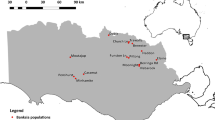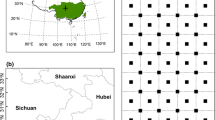Abstract
As with many invasive plant species, little is known of the population spatial patterns and stand dynamics of Lantana camara L. (Verbenaceae)—a thicket-forming weed of worldwide significance in managed and conservation lands, including coastal and inland habitats of Eastern Australia. Consequently, we mapped and followed annually for 3 years the demographic fate of more than 2000 Lantana individuals at sites with four land-uses (hoop pine plantation, cattle farm, and two eucalyptus forests with occasional grazing and periodic burning regime, respectively) in Queensland, SE Australia. Populations exhibited plant size distributions that were continuous (i.e., of L or symmetric type) and unimodal, except the farm population where bimodality was observed. Newly established plants could be reproductive within one growing season at ~50 cm in height, especially where environmental resources were not limiting. Density had an appreciable effect on the weed’s reproductive capacity and growth, but not on survival. Established and newly recruited individuals were aggregated but the degree of aggregation decreased with plant size. However, in the sites that had experienced burning or mechanical clearing, Lantana seedling/juvenile recruitment assumed negative association (spatial displacement) in relation to established individuals. The findings of this study agree with the notion that ecological processes often leave characteristic spatial signatures, which if interpreted using appropriate hypotheses can help to ascertain factors responsible for the observed spatial patterns and stand dynamics.





Similar content being viewed by others
References
Al-Sodany YM, Shaltout KH, Eid EM (2009) Demography of Ipomoea carnea: an invasive species in the Nile Delta, Egypt. Int J Agric Biol 11:501–508
Babu S, Love A, Babu CR (2009) Ecological restoration of Lantana-invaded landscapes in Corbett Tiger Reserve, India. Ecol Restor 27:467–477
Berry ZC, Wevill K, Curran TJ (2011) The invasive weed Lantana camara increases fire risk in dry rainforest through alteration of fuel loads. Weed Res 51:525–533
Call LJ, Nilsen ET (2003) Analysis of spatial patterns and spatial association between the invasive Tree-of-Heaven (Ailanthus altissima) and the Native Black Locust (Robinia pseudoacacia). Am Midl Nat 150:1–14
Carrion-Tacuri J, Rubio-Casal AE, de Cires A, Figueroa ME, Castillo JM (2011) Lantana camara L.: a weed with great light-acclimation capacity. Photosynthetica 49:321–329
Coutts SR, van Klinken RD, Yokomizo H, Buckley YM (2010) What are the key drivers of spread in invasive plants: dispersal, demography or landscape: and how can we use this knowledge to aid management? Biol Inv 13:1649–1661
Day MD, Wiley CJ, Playford J, Zalucki MP (2003) Lantana: current management status and future prospects. ACIAR Monograph series 102, Canberra, p 128
Diggle P (2003) Statistical analysis of spatial point patterns, 2nd edn. Academic Press, London
Duggin JA, Gentle CB (1998) Experimental evidence on the importance of disturbance intensity for invasion of Lantana camara L. in dry rainforest–open forest ecotones in north-eastern NSW, Australia. For Ecol Manage 109:279–292
Eichhorn MP (2010) Spatial organisation of a bimodal forest stand. J For Res 15:391–397
Gentle CB, Duggin JA (1997) Allelopathy as a competitive strategy in persistent thickets of Lantana camara L. in three Australian forest communities. Plant Ecol 132:85–95
Gooden B, French K, Turner PJ (2009) Invasion and management of a woody plant, Lantana camara L., alters vegetation diversity within wet sclerophyll forest in south eastern Australia. For Ecol Manage 257:960–967
Halpern CB, Antos JA, Rice JM, Haugo RD, Lang NL (2010) Tree invasion of a montane meadow complex: temporal trends, spatial patterns, and biotic interactions. J Veg Sci 21:717–732
Harper JL (1977) Population biology of plants. Academic Press, London
Hulme PE (2006) Beyond control: wider implications for the management of biological invasions. J Appl Ecol 43:835–847
Huston MA, DeAngelis DL (1987) Size bimodality in monospecific populations: A critical review of potential mechanisms. Am Nat 129:678–707
Lortie CJ, Munshaw M, DiTomaso J, Hierro JL (2010) The small scale spatiotemporal pattern of the seedbank and vegetation of a highly invasive weed, Centaurea solstitialis: strength in numbers. Oikos 119:428–436
Lowe S, Browne M, Boudjelas S, De-Poorter M (2004) One hundred of the world’s worst invasive alien species: a selection from the global invasive species database. Invasive Species Specialist Group, IUCN, Switzerland
Mack RN, Simberloff D, Lonsdale MW, Evans H, Clout M, Fakhri FA (2000) Biotic invasions: causes, epidemiology, global consequences and control. Ecol Appl 10:689–710
McCay TS, McCay DH, Caragiulo AV, Mandel TL (2009) Demography and distribution of the invasive Rhamnus cathartica in habitats of a fragmented landscape. J Torrey Bot Soc 136:110–121
McIntire EJB, Fajardo A (2009) Beyond description: the active and effective way to infer ` processes from spatial patterns. Ecology 90:46–56
Meekins JF, McCarthy BC (2002) Effect of population density on the demography of an invasive plant (Alliaria petiolata, Brassicaceae) population in a Southeastern Ohio Forest. Am Midl Nat 147:256–278
Metsaranta JM, Lieffers VJ (2008) Inequality of size and size increment in Pinus banksiana in relation to stand dynamics and annual growth rate. Ann Bot 101:561–571
Nanami S, Kawaguchi H, Yamakura T (2011) Spatial pattern formation and relative importance of intra and interspecific competition in codominant tree species Podocarpus nagi and Neolitsea aciculate. Ecol Res 26:37–46
Osunkoya OO, Perrett C (2011) Lantana camara L. (Verbenaceae) invasion effects on soil physicochemical properties. Biol Fertil Soils 47:349–355
Osunkoya OO, Perrett C, Fernando C (2010) Population viability analysis models for Lantana camara L. (Verbenaceae): a weed of national significance. In: Zydenbos SM (ed) Proceedings of the 17th Australasian weeds conference. New Zealand Plant Protection Society, Christchurch, pp 91–94
Perry GLW (2004) SpPack: spatial point pattern analysis in Excel using Visual Basic for Applications (VBA). Environ Model Softw 19:559–569
Perry GLW, Miller BP, Enright NJ (2006) A comparison of methods for the statistical analysis of spatial point patterns in plant ecology. Plant Ecol 187:59–82
Perry GLW, Enright NJ, Miller BP, Lamont BB (2008) Spatial patterns in species-rich sclerophyll shrublands of south western Australia. J Veg Sc 19:705–716
Ripley BD (1981) Spatial statistics. Wiley New York, New York USA
Schmucki R, De-Blois S (2009) Population structures and individual performances of Trillium grandiflorum in hedgerow and forest habitats. Plant Ecol 202:67–78
Sharma G, Raghubanshi A (2006) Tree population structure, regeneration and expected future composition at different levels of Lantana camara L. invasion in the Vindhyan tropical dry deciduous forest of India. Lyonia 11:25–37
Swarbrick JT, Willson BW, Hannan-Jones M (1995) Lantana camara L. Plant Prot Q 10:82–95
Totland OP, Nyeko P, Bjerknes A, Hegland SJ, Nielsen A (2005) Does forest gap size affect population size, plant size, reproductive success and pollination visitation in L. camara, a tropical invasive shrub? For Ecol Manage 215:329–338
Turner PJ, Downey PO (2008) The role of native birds in weed invasion, species decline, revegetation and reinvasion: consequences for lantana management. In: van Klinken RD, Osten VA, Panetta FD, Scanlan JC (eds) Proceedings of the 16th Australian weeds conference. Queensland Weeds Society, Brisbane, pp 30–32
Vivian-Smith G, Panetta FD (2009) Lantana (Lantana camara) seed bank dynamics: Seedling emergence and seed survival. Invasive Plant Sci Manage 2:141–150
Vivian-Smith G, Gosper CR, Wilson A, Hoad K (2006) Lantana camara and the fruit- and seed-damaging fly, Ophiomyia lantanae (Agromyzidae): Seed predator, recruitment promoter or dispersal disrupter? Biol Control 36:247–257
Warton DI, Wright IJ, Falster DS, Westoby M (2006) Bivariate line fitting methods for allometry. Biol Rev 81:259–291
Webber BL, Norton BA, Woodrow IE (2010) Disturbance affects spatial patterning and stand structure of a tropical rainforest tree. Aust J Ecol 35:423–434
Weiner J (1990) Asymmetric competition in plant populations. Trends Ecol Evol 5:360–364
Weiner J, Damgaard C (2006) Size-asymmetric competition and size-asymmetric growth in a spatially explicit zone-of-influence model of plant competition. Ecol Res 21:707–712
Wyszomirski T (1992) Detecting and displaying size bimodality: kurtosis, skewness and bimodalizable distributions. J Theor Biol 158:109–128
Acknowledgments
We thank volunteers who over the years helped in collection of the field data, especially Amanda Dimmock, Matthew Shortus, Jayd McCarthy and Stephen Caruana. The research was funded by the Queensland government through the Land Protection Council and by the Australian Federal Government through its Weeds of National Significance (WONS) program for L. camara.
Author information
Authors and Affiliations
Corresponding author
Appendix
Appendix
See Fig. 6.
Rights and permissions
About this article
Cite this article
Osunkoya, O.O., Perrett, C., Fernando, C. et al. Stand dynamics and spatial patterns across varying sites in the invasive Lantana camara L. (Verbenaceae). Plant Ecol 213, 883–897 (2012). https://doi.org/10.1007/s11258-012-0050-4
Received:
Accepted:
Published:
Issue Date:
DOI: https://doi.org/10.1007/s11258-012-0050-4





